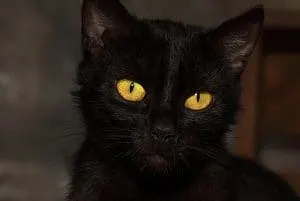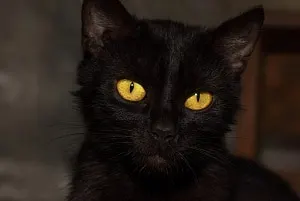 Health scares, occurring in reaction to symptoms such as eye redness or runny noses, are semi-frequent within many cat households. If the symptom you’re noticing is obvious, like eye redness, there’s likely something amiss in terms of your cat’s well-being. So, why do cats’ eyes turn red?
Health scares, occurring in reaction to symptoms such as eye redness or runny noses, are semi-frequent within many cat households. If the symptom you’re noticing is obvious, like eye redness, there’s likely something amiss in terms of your cat’s well-being. So, why do cats’ eyes turn red?
Cats’ eyes turn red as a symptom of an underlying health issue or infection. Eye redness can be caused by physical irritation from a small foreign object. Conjunctivitis and Uveitis are serious bacterial infections that cause red eyes in cats.
As there are several reasons your cat’s eyes could be turning red, it’s imperative to see a vet as soon as possible. Your vet will have to run tests to determine whether your cat is experiencing eye redness as a symptom of a severe health problem. In this article, we’ll talk about some of the common reasons your cat’s eyes turn red and tips for helping to treat your pet safely.
Why Is My Cat’s Eye Changing Color
Before we get into the more severe infections a cat may have as a cause of red eyes, we’ll get into some common causes.
In some instances, your cat’s red eyes could be relatively harmless. Perhaps she got dirt or fur stuck in it. When one of my kitten’s eyes turned red, it turned out she just had a piece of her hair stuck in it; the redness disappeared within the hour.
On the other hand, eye redness in cats could be a symptom of a respiratory tract infection.
In this specific case, your cat’s eyes will be squinty and red around the edges, featuring a considerable amount of discharge.
Often, cats with a respiratory tract infection also contract conjunctivitis. A quick visit to the vet and a week of antibiotics are sure to clear it up.
In more dire circumstances, eye redness and swelling could be symptoms of health problems such as cancer and autoimmune diseases. It may also be caused by various fungal, bacterial, or viral infections.
As there are virtually countless possible causes of your cat’s eye redness, it is necessary to bring it to a vet for an appointment as soon as possible for a checkup.
What Does a Cat Eye Infection Look Like
In general, a cat with red eyes may show this symptom because of an arise from several complex health issues; however, the symptom itself is difficult to miss.
Cats with eye infections often have redness around or on the eye itself. Most times, there is inflammation of the eye and eyelids, which makes the cat appear as if it’s squinting. Clear, yellow, or green discharge may also be present.
It can be hard to identify eye infections simply because cat owners may be in denial. Perhaps they’re terrified of their pet being sick, or they can’t afford a vet bill.
It is crucial to notice the signs of an eye infection and act quickly. Even if there’s just dust in your cat’s eye, it is worthwhile to make sure it won’t lead to anything more serious—especially if it looks painful to your cat.
Conjunctivitis In Cats
Conjunctivitis is usually of minimal concern. It is a minor eye infection characterized by the inflammation of the clear membranes that cover the eyelid and eyeball.
Usually contracted via a bacterial or viral infection, conjunctivitis can develop into a more severe problem if it or the disease is left untreated. Infectious conjunctivitis can be spread to other cats, so make sure to keep your house cats separated before and during treatment.
But, will conjunctivitis go away by itself? Yes, in mild cases, conjunctivitis in cats may go away on its own. However, in most circumstances, you don’t want to try and find out if it will. The longer you leave the infected eye(s) untreated, the longer your cat will be in pain.
The last thing you want to do is leave your cat in a constant state of irritation.
Conjunctivitis in cats is just as painful as it is in humans. Those who’ve contracted it can attest to the intense stinging it inflicts and crusting eyelids that you have to pry apart after sleeping.
Your cat may not be meowing or yowling in pain, but you should recognize that while silent, they could still be experiencing discomfort.
If you’d get yourself medicine to treat conjunctivitis, you should provide the same care for your cat.
Your veterinarian will prescribe eye drops in the case of a bacterial or viral infection, or if a foreign object had caused the irritation. It could take from a few days to up to two weeks to resolve.
Uveitis in Cats
Uveitis is much more concerning the inflammatory issue. Usually, it signals the presence of a variety of severe health problems, such as tumors, cancer, autoimmune diseases, and severe viral, bacterial, or fungal infections.
Uveitis is the inflammation of the uvea or the front of the eye, including the iris and pupil. While it may be more challenging to identify in its early stages, uveitis in cats is characterized by redness, swelling, and cloudiness of the eyeball, as well as discharge.
So, how does a cat get Uveitis? A cat can get Uveitis by scratching their eye, poor nutrition, or contracting fungal infections through unsanitary conditions. Most healthy cats won’t get this, but those who are not well taken care of can be subject to this and many more diseases.
Visit your vet at the first sign of eye redness; ruling out or catching uveitis early is crucial.
Treatment consists of reducing inflammation of the eye via eye drops or ointment while nursing the underlying cause.
How Can I Treat My Cat’s Eye Infection at Home
Unless your cat has eye irritation and redness from getting a piece of dirt or dust stuck in it, you should not provide treatment at home. If you can identify the object that may be irritating your cat’s eye, remove it safely, and perform an eyewash.
If you’re worried about the cost of treatment for your cat’s eye infection, I implore you to take them to the vet anyway. Even a $100 vet bill is better news than your cat losing its vision, or worse, its eye and the surrounding tissue.
In more mild cases, you may be able to get away with herbal treatments. Apple cider vinegar applied to the back of the neck three times daily may help fight the bacteria in the cat’s infected eye.
Of course, if the herbal treatment of your choice still hasn’t worked after a few days, it’s time to visit the vet.
Many “DIY” or “at home herbal” eye infection remedies either don’t work or are just plain dangerous. It’s worth it to visit a professional rather than rely on amateur treatments with no sound data to back them up.
Avoid touching the cat’s eye to remove discharge, as you could transfer more bacteria to the infected eye. A warm washcloth or cotton ball will do.
Conclusion
A cat’s reddening eyes can be worrisome. All we want is our fur babies to be in perfect health.
Part of ensuring your kitty’s well-being is to accept that getting sick is out of your control. What you can control, however, is the treatment and TLC they receive on the road to recovery.
The bottom line of eye infections is that the vet is your friend. No matter the cause behind the symptoms, veterinarians are the ones who will be able to identify what’s causing your cat so much discomfort.
Take the safe route and get your cat the professional help it deserves. Even if their infection turns out to be minor, rest assured that you prevented it from getting worse or causing them further pain.

My name is James, and welcome to FAQCats!
Along with our team of cat owners, expert pet enthusiasts, and pet professionals, we aim to write engaging helpful, engaging content about cats. At FAQCats we strive to provide content that’s accurate and fun to read. Our team writes about everything related to cats; even the most complex of topics. Through extensive research and caring for our own fur-pals, we’re able to provide something cat owners worldwide will love. Have a look around, and leave us feedback anytime!

